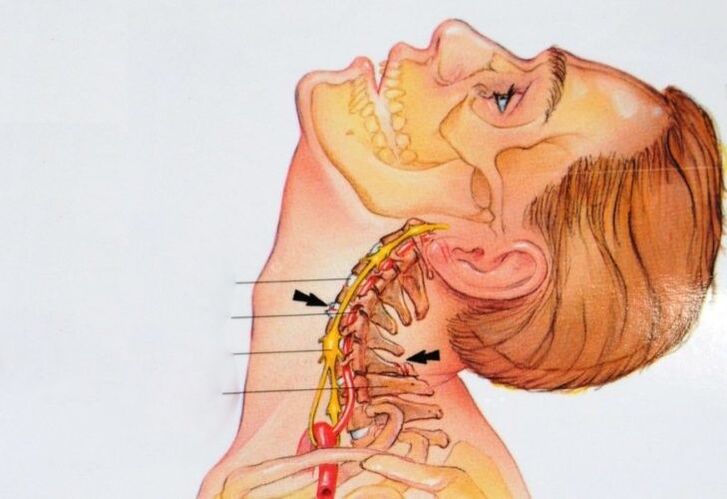Osteochondrosis of the cervical spine is a disease characterized by damage to the intervertebral discs.
Cervical osteochondrosis is one of the most common diseases in the world. Statistically, around 60% of the world's population has faced it as modern people suffer from physical inactivity and also spend a lot of time in sedentary work. Osteochondrosis manifests itself in the form of damage to the intervertebral cartilage, as well as reactive processes in adjacent tissues.
The vertebrae of the cervical spine are much smaller than the vertebrae of other spinal columns, but the load is no less. We constantly turn our head, so the neck is in a systematic movement. In the initial stages, the disease is difficult to identify, and the basic manifestations of the disease are often ignored by patients. The result is the introduction of cervical spine osteochondrosis, which significantly complicates the further treatment process.
A modern clinic successfully treats osteochondrosis of the neck using non-surgical methods through correction and kinesitherapy.

Causes of osteochondrosis of the neck
There are several factors that can contribute to the development of osteochondrosis:
- Physical inactivity is the main reason that precedes the development of a dangerous disease. The complete absence of moderate physical activity leads to the breakdown of the muscular and bony skeleton. Inadequate daily activity is not just a problem for office workers and drivers. People who prefer to spend their free time on the computer or in front of the television suffer from hypodynamia.
- Excessive physical activity. Professional athletes who are exposed to axial loads on their backs most often suffer from this. Working at the limit of possibilities also threatens beginners who train without the supervision of a professional trainer and perform exercises with improperly adjusted technique.
- Negative factors for posture are walking in high heels and in uncomfortable shoes, scoliosis, flat feet and incorrect posture while sleeping.
- Being overweight puts excessive strain on the spine, which leads to a shift in the vertebrae and wear and tear on the cartilage structures.
- Rheumatism.
- Disorders of the endocrine system.
- Emphasize.
- Throat hypothermia.
- Sedentary lifestyle (e. g. drivers and office workers) or excessive physical activity (e. g. athletes).
As a rule, under the influence of these factors, there is a load on the cervical vertebrae, which leads to the formation of muscle spasms. This disrupts blood flow and metabolism deteriorates, which leads to degenerative changes.
An interesting fact: the risk of developing a disease like osteochondrosis is largely linked to evolutionary changes in the human body. It's about walking upright. During the entire life cycle, the spine fulfills the function of the "core" of our body. The vertebrae that press on the cartilage discs gradually wear out, so that the connective tissue is broken down. For this reason, osteochondrosis often becomes noticeable in old age.
Symptoms and treatment for cervical spine osteochondrosis largely depend on the reasons that caused the onset of the disease. In order to develop an individual therapy plan, doctors carry out a whole series of examinations. Self-medication for neck pain is strongly discouraged. Incorrect massages, medication or conventional medical methods can make the situation worse and lead to many irreparable consequences!

Cervical osteochondrosis: symptoms and treatment
The manifestations of a dangerous disease depend on 2 main factors:
- Type of load on the cervical spine.
- The site of damage to the cartilage structure of the intervertebral disc.
The nerve roots perform a wide variety of functions, so the symptoms of damage to their individual parts can vary widely. In addition, you need to take into account the stage of development of the disease. There are 4 of them, each of which following one is heavier than the previous one.
Cervical osteochondrosis 1 degree
This level is known as preclinical and is poorly developed, which is why patients attribute symptoms to stress, lack of sleep, and other seemingly frivolous problems. The spine begins to defend itself against "destructive" movement and excessive stress that makes people feel uncomfortable.
The main symptoms are:
- a headache
- Discomfort in the neck, shoulders and arms
- slight visual impairment
- a slight decrease in motor activity of the neck
One of the most noticeable symptoms of the preclinical stage of cervical osteochondrosis is constant tension in the neck muscles. The muscles quickly overload, which leads to a tolerable feeling of pain and a crunch when turning / tilting the head.
Since the above problems do not cause much discomfort, most patients prefer to let the situation take its course. In fact, it is already necessary to begin the treatment of osteochondrosis of the cervical spine, because the earlier therapy begins, the more effective it will be.
Grade 2 cervical osteochondrosis
In this case, patients experience noticeable pain when tilting / turning their head. Often unpleasant sensations spread to arms, shoulder joints and hands. Problems with the state of the nervous system arise: a person becomes irritable, distracted, their daily ability to work is noticeably reduced. The basic symptoms of cervical osteochondrosis in women are almost identical to the symptoms of problems with the reproductive system (weakness, fatigue, apathetic mood, and much more).
Despite the obvious signs of the development of the disease, it is still possible to get rid of osteochondrosis of the neck. First, doctors work to eliminate the risk of hernias, which lead to a deterioration in limb mobility and blood flow to the brain.
The main symptoms are:
- severe neck pain
- Noises in the ears
- Visual impairment
- decreased skin sensitivity on shoulders and arms
- Worsening of tendon reflexes
Cervical osteochondrosis 3 degrees
At this stage of development, the disease is already considered neglected. The treatment of cervical osteochondrosis in stage 3 is more difficult because the destruction / deformation of the cartilaginous structures is often irreversible. The pain syndrome becomes stronger, which is accompanied by the active development of hernias and the friction of the bone tissues of the vertebrae with each other.
In addition to pain, the patient feels weakness and complains of dizziness. The reason for this is the injury to large vessels and nerves that run through the spine. The brain receives too little food and oxygen, which can lead to a clouding of consciousness. The pain radiates to the upper extremities, there is a feeling of weakness in the arms. Another clear sign of degree 3 osteochondrosis is loss of sensitivity in the fingers and a tingling sensation in them.
The main symptoms are:
- increased pain
- Cervical spine hernia
- very weak tendon reflexes
- Paralysis of the upper limbs
Grade 4 cervical osteochondrosis
The cartilage tissue of the intervertebral discs has already changed significantly due to destruction. At stage 4 of the disease, protrusions and hernias appear in 99% of cases, which have a significantly negative effect on the patient's condition. The body begins to regenerate on its own and "builds up" tissue in the areas of the damaged intervertebral discs. As a result, the column itself loses its mobility.
As the nerves and blood vessels become compressed, the person loses coordination of movements. Drowsiness, apathy, and pain only increase. Patients often complain of bothersome tinnitus. In addition, stage 4 cervical osteochondrosis threatens a number of the following consequences:
- Cerebral ischemia, the risk of developing a stroke. This is due to severe compression of the vertebral arteries.
- Impaired perception of the environment and systematic loss of consciousness. The reason is the pinching of the blood vessels and the insufficient blood supply to the cerebral cortex.
- Fatal outcome. A spinal cord obstruction can be a disastrous consequence.
The main symptoms are:
- Brain activity depression
- Lack of coordination
- increased dizziness
- paralysis
- Hearing and vision loss
- Angina, shortness of breath
How to cure cervical osteochondrosis: the diagnostic stage
Before starting to get rid of the disease, doctors conduct a comprehensive examination of the patient's cervical spine. This is necessary to establish the presence and neglect of the disease. The diagnosis consists of several stages:
- Roentgen. This is a visual way of determining the position of the vertebrae as well as changes in their mobility.
- Laboratory research. With the help of tests, doctors determine diseases of the spine, and also make a definitive diagnosis.
- CT. This is a modern method for assessing ruptures and changes in height of intervertebral discs. Computed tomography also helps to track the instability of individual vertebrae.
- MRI. The presented stage of the examination is carried out to determine the condition of the nerve roots, the quality of blood circulation, as well as pathological changes in the cartilage / bone structures.
- Differential diagnostics. This includes an ultrasound scan, a cardiogram, and several other procedures. They are necessary in order not to confuse osteochondrosis with other diseases with identical symptoms. These include diseases of the urinary tract, all types of deformities of the spine, hip injuries and diseases of the central nervous system.
Establishing symptoms and treating cervical osteochondrosis is impossible without a comprehensive diagnosis. The earlier it is done, the more effective the therapy. If you experience symptoms of the disease, see your general practitioner as soon as possible. He will give referrals for appointments with specialists with a narrower profile: a neurologist and an orthopedic surgeon. In some cases, it may be necessary to see a cardiologist if the symptoms overlap with suspected angina or ischemia of the heart muscle.

In modern clinics, the diagnosis and successful treatment of osteochondrosis of the neck is carried out on the basis of kinesitherapy. With the help of this healing technique, patients who perform a series of physical exercises on special training equipment for recovery significantly improve their health.
Treatment of cervical osteochondrosis in women and men basic methods
A high quality and stable result in the treatment of osteochondrosis of the cervical spine can only be achieved with an integrated approach to the problem. The effectiveness of recovery largely depends on the patient's mood, which has to completely revise the lifestyle, diet, sleep and wakefulness.
Independent treatment of osteochondrosis of the cervical spine in women and men is by no means possible, since the basic symptoms of the disease can indicate the development of a completely different disease. Drugs selected without the doctor's knowledge can seriously worsen the situation. Even the elementary intake of painkillers does not always have the expected effect, which once again proves the need for prior consultation with a specialist.
Elimination of exacerbations of pain
The disease often manifests itself in the form of a stabbing, aching and pulling pain syndrome. The main task of the doctor is to relieve your suffering, so specialists first prescribe:
- Anti-inflammatory drugs;
- Vitamins;
- Painkiller;
- Chondroprotectors.
The last category of drugs is aimed at the restoration of cartilage structures, which is especially important in advanced stages of the disease. In addition, patients are prescribed drugs to relieve muscle spasms and improve blood flow to the body.
Therapeutic gymnastics exercises
Physiotherapy specialists know how to get rid of cervical osteochondrosis in the most cost-effective way. Exercise therapy is one of the most effective methods of treating osteochondrosis that can also be used at home. The intensity of the exercise does not matter. The regularity of moderate physical activity will help achieve the result. Here is the effect of exercise:
- Strengthening the neck muscles, which are responsible for supporting weakened vertebrae.
- Stimulation and normalization of the blood supply in the body, which is particularly important for the cerebral cortex.
- Increase in general tone, charge of energy, restoration of a person's productivity and ability to work.
Exercise therapy classes are allowed daily. The exercise set includes all types of head rotations and tilts. With appropriate physical fitness, the level of difficulty increases and hand movements are combined with work. The advantage of therapeutic gymnastics elements is that they can also be used in the workplace. But remember that they can only be done after the acute pain syndrome has been eliminated.
As an additional burden, doctors recommend that patients visit the swimming pool, as swimming relieves the spine and relieves the pressure on the intervertebral discs. Shown and worked with light dumbbells to strengthen the shoulder girdle.
physical therapy
Physiotherapy methods are numerous:
- Electrophoresis.
- Magnetotherapy, laser and shock wave therapy.
- Mud therapy.
- Medicinal baths and showers.
The above are just the main therapeutic methods aimed at restoring blood supply to the affected spine, eliminating inflammation and pain, and slowing down the process of ossification of the neck.
massage
The treatment of cervical osteochondrosis of the spine with massage is widespread worldwide. However, this method must be used with the greatest care, since a rough and clumsy blow to the damaged parts of the neck can lead to the deterioration of the condition. Before making an appointment with a masseur, you should consult your doctor.
Thanks to the influence of the hands on the sore area, muscle tone decreases, which leads to the elimination of painful cramps. It also improves blood circulation, restores clarity of thought and the patient's general well-being.
surgery
The last stage of the development of the disease leads to the formation of severe intervertebral hernias, as well as narrowing of the lumen of the spine. Treatment of the patient in this case may require surgical intervention. The surgeon decides whether an operation is necessary. He also determines the complex of preparatory measures, the period of postoperative recovery and rehabilitation.
Most surgical procedures involve removing the resulting hernia as well as replacing damaged vertebrae.
Treatment of cervical osteochondrosis in the clinic
Treatment of osteochondrosis of the cervical spine in a professional clinic involves exclusively non-surgical methods. Specialists work according to a unique technique developed on the basis of the principles of exercise therapy. Patients who come to us are treated with a series of physical exercises in a specially equipped room.
The treatment of cervical osteochondrosis is carried out according to an individually developed program. The therapeutic effect affects not only a specific part of the spine, but also the internal organs. The drug-free and non-surgical treatment process is difficult, but we give patients comprehensive support, help them become more determined and rethink their attitudes towards their own illness.
The healing process is based on:
- Training in the rehabilitation room at least 2-3 times a week.
- Ground floor therapeutic gymnastics.
- Thermotherapy according to individual indications.
- Pain relief with ice massage.
- Therapeutic / restorative massage.
- Adaptive exercises for work at home.
- Microanatomical ultrasound scans to track recovery over time.
- Personal consultations with the specialists at the movement clinic.

Prevention of osteochondrosis
Treatment of osteochondrosis of the cervical spine in modern medicine includes many effective methods. But it is much better not to let this problem arise at all than to deal with its elimination. There are a number of preventive measures that will minimize the risk of occurrence and development of a dangerous disease:
- Take a 10-minute hot shower every day. A systematic visit to the baths / saunas is also recommended. Please note that these recommendations are only for people who do not have any cardiovascular health problems.
- Go swimming and take regular walks in the fresh air at a relaxed pace. Sedentary lifestyle is one of the main causes of musculoskeletal disorders.
- Reject excessive physical exertion at the limit of human ability. This is especially true when working in gyms. Critical axial loads on the spine lead to protrusion.
- Try to avoid back stitches, especially if you are over 30 years old.
- Check your diet. Try to exclude confectionery, flour, moderate salt and sugar intake. By reducing the calorie content of food, you can avoid gaining weight, which puts additional strain on the spine.
- If you work in the office and spend a lot of time at the computer, be sure to get a special chair with a lumbar and neck support. Try to do basic warm-ups every 60 minutes.
- In case you experience pain after waking up, consider purchasing an orthopedic mattress and pillow. If possible, get a bed with a flat, hard surface.
- To prevent degenerative and dystrophic changes in the cervical spine, you should visit a professional masseur at least 2-3 times a year. Neck and collar massage is one of the most effective preventive measures.
- Women should minimize walking on high-heeled shoes as it affects the natural position of the spine. If you have diagnosed flat feet, it is advisable to buy special shoes or insoles, as orthopedic products correct the position of the feet and unnecessarily relieve the spine.
And also:
- you should go to the bathroom regularly
- You need to give up bodybuilding, which can contribute to the prominence of the cervical disc
- Gentle exercise can be a good preventive measure against illness
Result
Treatment of osteochondrosis in a professional clinic is carried out under the strict supervision of highly qualified specialists. Doctors take an integrated approach to working with patients and even deal with advanced stages of the disease. If you experience symptoms of osteochondrosis, you don't have to endure, self-medicate and postpone a visit to the doctor. Start your journey to a healthy, happy life!

















































